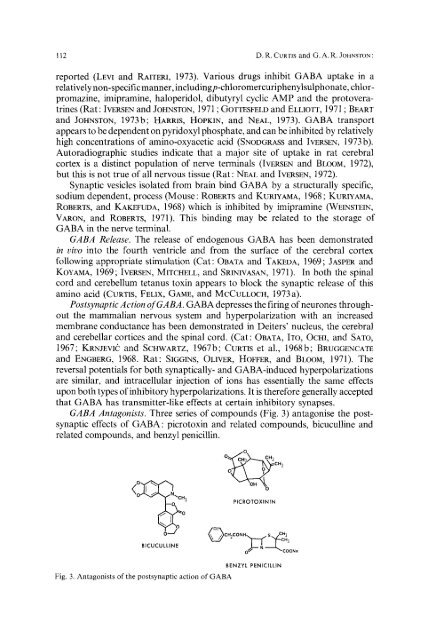Amino acid transmitters in the mammalian central nervous system
Amino acid transmitters in the mammalian central nervous system
Amino acid transmitters in the mammalian central nervous system
Create successful ePaper yourself
Turn your PDF publications into a flip-book with our unique Google optimized e-Paper software.
112 D.R. CURTIS and G.A.R. JOHNSTON:<br />
reported (LEvi and RAITERI, 1973). Various drugs <strong>in</strong>hibit GABA uptake <strong>in</strong> a<br />
relatively non-specificmanner, <strong>in</strong>clud<strong>in</strong>gp-chloromercuriphenylsulphonate, chlorpromaz<strong>in</strong>e,<br />
imipram<strong>in</strong>e, haloperidol, dibutyryl cyclic AMP and <strong>the</strong> protoveratr<strong>in</strong>es<br />
(Rat: IVERSEN and JOHNSTON, 1971 ; GOTTESFELD and ELLIOTT, 1971 ; BEART<br />
and JOHNSTON, 1973b; HARRIS, HOPKIN, and NEAL, 1973). GABA transport<br />
appears to be dependent on pyridoxyl phosphate, and can be <strong>in</strong>hibited by relatively<br />
high concentrations of am<strong>in</strong>o-oxyacetic <strong>acid</strong> (SNODGRASS and IVERSEN, 1973 b).<br />
Autoradiographic studies <strong>in</strong>dicate that a major site of uptake <strong>in</strong> rat cerebral<br />
cortex is a dist<strong>in</strong>ct population of nerve term<strong>in</strong>als (IvERSEN and BLOOM, 1972),<br />
but this is not true of all <strong>nervous</strong> tissue (Rat: NEAL and IVERSEN, 1972).<br />
Synaptic vesicles isolated from bra<strong>in</strong> b<strong>in</strong>d GABA by a structurally specific,<br />
sodium dependent, process (Mouse: ROBERTS and KURIYAMA, 1968 ; KURIYAMA,<br />
ROBERTS, and KAKEFUDA, 1968) which is <strong>in</strong>hibited by imipram<strong>in</strong>e (WEINSTEIN,<br />
VARON, and ROBERTS, 1971). This b<strong>in</strong>d<strong>in</strong>g may be related to <strong>the</strong> storage of<br />
GABA <strong>in</strong> <strong>the</strong> nerve term<strong>in</strong>al.<br />
GABA Release. The release of endogenous GABA has been demonstrated<br />
<strong>in</strong> vivo <strong>in</strong>to <strong>the</strong> fourth ventricle and from <strong>the</strong> surface of <strong>the</strong> cerebral cortex<br />
follow<strong>in</strong>g appropriate stimulation (Cat: OBATA and TAKEDA, 1969; JASPER and<br />
KOYAMA, 1969; IVERSEN, MITCHELL, and SRINIVASAN, 1971). In both <strong>the</strong> sp<strong>in</strong>al<br />
cord and cerebellum tetanus tox<strong>in</strong> appears to block <strong>the</strong> synaptic release of this<br />
am<strong>in</strong>o <strong>acid</strong> (CURTIS, FELIX, GAME, and MCCULLOCH, 1973a).<br />
Postsynaptic Action ofGABA. GABA depresses <strong>the</strong> fir<strong>in</strong>g of neurones throughout<br />
<strong>the</strong> <strong>mammalian</strong> <strong>nervous</strong> <strong>system</strong> and hyperpolarization with an <strong>in</strong>creased<br />
membrane conductance has been demonstrated <strong>in</strong> Deiters' nucleus, <strong>the</strong> cerebral<br />
and cerebellar cortices and <strong>the</strong> sp<strong>in</strong>al cord. (Cat: OBATA, ITO, OCHI, and SATO,<br />
1967; KRNJEVI~ and SCHWARTZ, 1967b; CURTIS et al., 1968b; BRUGGENCATE<br />
and ENGBERG, 1968. Rat: SIGGINS, OLIVER, HOFFER, and BLOOM, 1971). The<br />
reversal potentials for both synaptically- and GABA-<strong>in</strong>duced hyperpolarizations<br />
are similar, and <strong>in</strong>tracellular <strong>in</strong>jection of ions has essentially <strong>the</strong> same effects<br />
upon both types of <strong>in</strong>hibitory hyperpolarizations. It is <strong>the</strong>refore generally accepted<br />
that GABA has transmitter-like effects at certa<strong>in</strong> <strong>in</strong>hibitory synapses.<br />
GABA Antagonists'. Three series of compounds (Fig. 3) antagonise <strong>the</strong> postsynaptic<br />
effects of GABA: picrotox<strong>in</strong> and related compounds, bicucull<strong>in</strong>e and<br />
related compounds, and benzyl penicill<strong>in</strong>.<br />
<<br />
~~N~cH3<br />
o ?<br />
PICROTOXININ<br />
CH2CONH S CH3<br />
BICUCULLINE<br />
o/A --" -~cooN~<br />
BENZYI. PENICILLIN<br />
Fig. 3. Antagonists of <strong>the</strong> postsynaptic action of GABA













